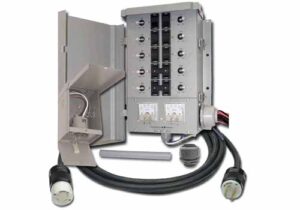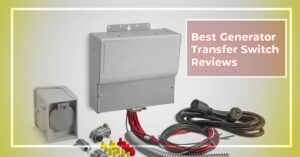
Once we could blame power outage for many of our losses. Generators have been on the scene to let us stop it and focus on continued productivity.
What if we would have to connect the unit directly to the electrical panel and couldn’t use a generator transfer switch? Our useful home appliances would be wasted every now and then. No need to be an expert to tell this! So, the idea of getting the right generator transfer switch is practical.
Choosing anything electrical or mechanical is never easy for those without knowledge and expertise in it. But, it doesn’t have to be a way over your head either. So, I’m here with the best generator transfer switch reviews with a well-researched buying guide. By the end, you’ll feel it’s just easy to make a perfect choice; I promise you that!
Editors Pick
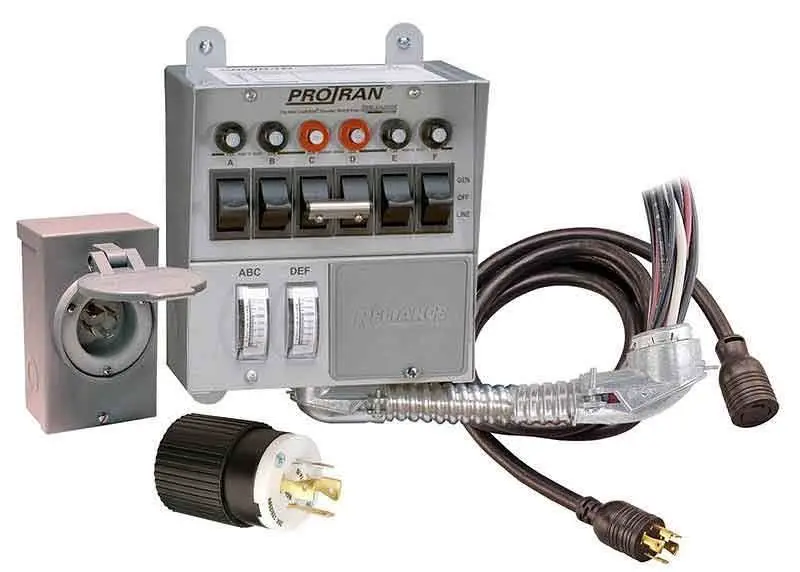
Spending hours researching these switches, our experts marked this Reliance Controls Corporation 31406CRK as the best to pick.
They found it as a complete package of portable generator transfer switch installation including circuit breakers, toggle switches, wattmeter, built-in junction box, 30A Power Inlet Box, conduit whip, power cord, and plug. It is easier to use, safe and suitable for home and office use.
We recommend this product based on our hard research and hundreds of reviews of real users.
Happy installation!
5 Best Generator Transfer Switch Comparison Chart
Before starting the review of each transfer switch for portable generators, I would like you to take a glance at the essential specs of them, so you can decide which one is worth your time (as you go into its details).
| Name | Amp | Wattage | Weight(pounds) | Price |
|---|---|---|---|---|
 Reliance Controls 31406CRK | 30 | 7,500 | 0.01 | Check Price |
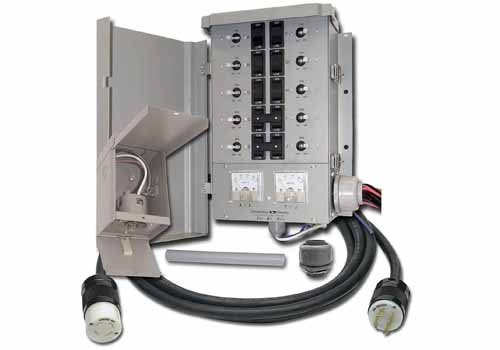 Connecticut Electric EGS107501G2 | 30 | 7,500 | 0.01 | Check Price |
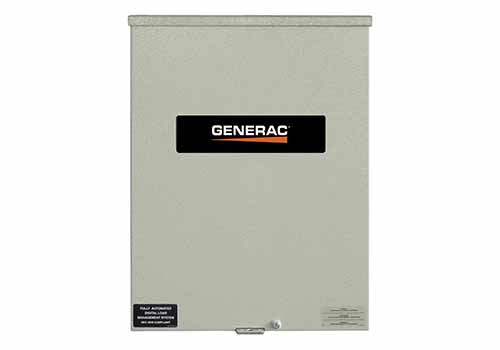 Generac RTSW200A3 200 Amp | 200 | 48,000 | 0.01 | Check Price |
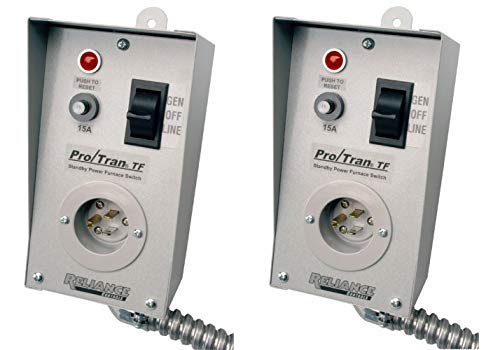 Reliance Controls TF151W | 15 | 1,875 | 5 | Check Price |
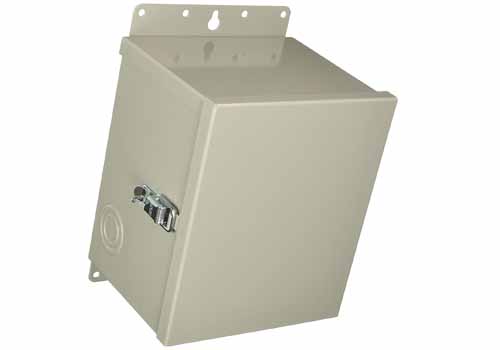 Reliance Controls CSR302 | 30 | 7,500 | 10.65 | Check Price |
1. Reliance 31406CRK 30 Amp 6-circuit Pro/ Transfer Switch Kit for Generators
Reliance Controls Corporation has addressed one BIG concern that the transfer of electrical power between the sources and appliances has to be comfortable and safe. The 31406CRK Pro/Tran Transfer Kit includes circuit breakers, toggle switches, wattmeter, built-in junction box, conduit whip, power cord, and plug; all designed to make it the best transfer switch.
Being operated by a toggle, each switch circuit comes with a built-in 15-20 Amp branch-rated circuit breaker that protects it with the toggle switch being in the GEN mode. In the LINE mode, the breakers protect the branch circuits in the load center.
Using the toggle switches are easy as you can choose between GEN and LINE for powering the branch circuits. You don’t want to use the OFF position because it isolates a particular circuit from both GEN and LINE.
Pros
- Straightforward installation and setup
- Suitable for both residential and commercial purposes
- Efficient circuit breakers
- Neatly arranged wires
- cUL1008 Listed
Cons
- Improvements required for AFCI breaker
How much of power your appliances are draining off your generator is measured in watts, and the job of the Wattmeter is to let you know the total load. You can learn how close the generator is getting to its entire capacity. So, look at the meters and forget worrying about overloading issues.
The conduit whip contains wires (ground, hot, and neutral) that connect the circuit breakers and the transfer switch in the load center. Each circuit includes identifiable color-coded cables (one red and one black). You’ll get the red one connected to your circuit breaker in the major load center while the black one connected using a wire nut to the specific load wire for that particular circuit.
30 Amp NEMA Power Inlet box is designed to allow direct wiring to the load center and the transfer switch from a remote point. 30 Amp outdoor power cord has two ends with one plugging into the generator’s outlet and another into the inlet box. The 20 Amp plug end lets you replace the 30 Amp cord and use it on other generators (small units) using 20 Amp outlets.
So, what else do you need to ensure that the appliances don’t get fried, utility workers and the generator stay protected? The 31406CRK Pro/Tran Kit is well-equipped!
2. Connecticut Electric EGS107501G2 Circuit Transfer Switch Kit
Connecticut EGS107501G2KIT Transfer Switch Kit includes a 10 circuit transfer switch, a rainproof generator inlet box, and a 10-foot power cord. Like every manufacturer, Connecticut Electric also claims that this EmerGen kit eases the transfer of power with adequate safety. Let’s see how.
Whether you want to install it in an indoor setup or an outdoor environment, it should be suitable for a generator (portable ones actually) with 30-amp/7,500-watt output. The rainproof power inlet casing withstands daily wear and tear quite capable.
Pros
- Heavy-duty design and construction
- Suitable for both indoor and outdoor applications
- Compatible with load centers from all manufacturers
- Rainproof inlet box
- Easy instruction manual
Cons
- Brief warranty period (1 year only)
- The conduit being not flexible enough to bend easily
Two throw rocker switches deal with the occurrence and associated dangers of back-feeding efficiently. The two-pole circuits make it ideal for a well or a sump pump.
It’s going to be just the right kind of transfer switch when you have a collection of 240-volt electric appliances, and there’re frequent instances of a power outage.
As you don’t need the two-pole settings, you can remove the two screws to remove the tie bar and turn the thing into two single-pole components.
Don’t worry about any particular load center because this switch comes built with the provision for just about all centers including the most prominent ones like CH, Challenger, Homeline, GE, Square D, Westinghouse, and Siemens.
This transfer switch for portable generators includes a 1-year warranty which may seem somewhat scanty, but the UL-listed kit has some popularity among users who left a lot of positive reviews that talk about its overall efficiency.
3. Generac RTSW200A3 200 Amp Automatic Transfer Switch
Sure, you need not worry if there’s the need for something that handles loads of multiple HVAC units at the same time. Generac RTSW200A3, a single-phase transfer switch requires no additional hardware but does the job nicely. All you should watch out for one thing that the generator has to be a single-phase model.
Use a board consisting of the transfer switch and load management hardware and finish the installation sooner than you may imagine. Trust me, no complexity so far! Also, the Smart Management systems make your outdoor applications a breeze. The A/C Module sheds the connected loads during overload and thereby handles the loads.
Pros
- Easy to install with no additional hardware required
- Suitable for higher wattages (up to 48,000)
- Automatic load management
- Durable enclosure for the switch
- UL and CUL listed
Cons
- An extended warranty period could be allowed.
- More expensive than most Transfer Switches.
Here we’re with the Digital Load Management system that, if put to use, allows the switches to handle loads of two air conditioning units. During emergency needs outdoor, the technology shows its further excellence by handling loads of four units, and this is done quite smartly.
The NEMA enclosure made of 3R rated aluminum makes the product durable while the baked powder paint that is electrostatically applied on the closure offers corrosion resistance to some extent.
With advanced technology and sturdy enclosure, this portable generator transfer switch proves valuable in not only an outdoor situation but also a household or commercial or industrial setup.
4. Reliance Controls TF151W Easy/Tran Transfer Switch for Generators
This time, I’m talking about a small yet technically standard transfer switch that uses a high-quality grounded extension cord and works for a single circuit.
The 15 Amp push-to-reset circuit breaker is designed to offer all-out protection for the branch circuit as the GEN mode is on. On the other hand, the LINE position involves the use of the furnace breaker for protecting the branch circuit. So, no worries about the damage!
Pros
- Easy installation
- An excellent choice for indoor uses
- Suitable for most portable generators
- Flexible conduit whip
Cons
- No UL certification
- No wattmeter included
When you want to toggle between generator and utility as your preferred source of power, there’s a Toggle Switch that lets you use either GEN or LINE. You may ignore the use of the OFF mode. It won’t hurt!
Sorry, no double pole circuits! But, connecting the switch to the circuit breaker in the load center is never easier! Thanks to the pre-wired aluminum conduit that contains color-coded wires (2 hot, 1 neutral, and 1 ground).
The Panel Light! Some might take it for an ignoble part, but I think it is somewhat important as it gets on just when the generator is in use.
As I said, it’s small, you may expect its compatibility with a generator with 1875 running watts, be it portable, or an inverter, or an RV, and any unit that delivers the required current.
5. Reliance Controls 30-Amp Outdoor Transfer Switch for Generator
Maybe, Reliance Controls has gone way too far with the versatility of this transfer switch.
You can rely on it for controlling power transfer system for a vast number of setups like cell towers, community wells, commercial and residential garage doors, electric heaters and water heaters, farm buildings, sump pumps, irrigation systems, water and sewer lift stations, telecommunication substations, etc.
Let’s get to the actual point here, the generators, I guess. A unit having 7,500 running watts should be just fine. Nothing is about to test you, the installation, or the use!
Look at the steel cabinet! It comes powder-coated and zinc plated, perfect for an outdoor application; no matter how heavy that is going to be.
Pros
- Reliable in emergencies
- Versatile applications besides uses for generators
- Easy installation and use
- Good specs for the price
- Heavy-duty switch and durable construction
Cons
- Wires being too short to suffice in the circumstances and the wiring instructions being a bit confusing
Oh, I forgot one of its great uses, the traffic signal applications! You can use the toggle type switches get back to the utility power incredibly fast, in under 250 milliseconds. Well, don’t worry about the signals as they’re not going to operate blinkingly during the transfer.
Remember one thing: everything that you plan for this transfer switch has to have a single circuit. Only then, this switch allows you to use the backup power without back-feeding your utility line in case of an outage. Well, safety! Even an emergency can be taken care of by it (no need to remember shutting off your primary source of power in the face of a situation!). Thus, some of our buddies consider it the best manual transfer switch!
What’s a Transfer Switch and What Does It Mean for a Generator?
The typical job of a transfer switch is to supply/transport power to a particular electrical circuit collected from multiple sources. These switches are nowadays indispensable components to keep for back-up generator systems.
It’s a device that connects a generator safely to the power (electrical) system within a house, commercial building, or an industrial setup. The reason why the switch is of some value is the efficiency, simplicity, and safety it maintains while transferring the power from the electrical grid to an electronic unit like a generator.
Reasons why a Transfer Switch Is a Necessity?
A generator works just fine without the switch, and you may skip it as well, but you don’t want to because,
- Without it, the transfer process is going to be demanding and slow.
- You don’t want to stay on the unsafe side of the fence when dealing with electricity.
- You’ll only see the access to power being limited with the plugging method.
- You hate to see your appliances/generator getting fried due to back-feeding instances.
How to Choose the Right Generator Transfer Switch?
Getting a first-rate transfer switch involves many considerations, such as the type of options available, associated technicalities, and your expected demand for power. I’ll discuss these factors in small fractions to make the whole thing understandable.
Types
You’ll find two types of switches depending on the way you can operate them.
Automatic Transfer Switch (ATS)
Manual Transfer Switch
We’ll discuss the deciding factors for both automatic and manual switches. So, please have some patience to get a complete understanding.
What to Look for in an Automatic Switch?
A solid state system of transferring power is the key factor that makes an automatic switch a preferable option. You need not toggle on anything to get it functional or stopped.
There are several technical factors that you need to observe closely to find the right automatic switch.
Operational Style
Four operational styles are available.
Open-Transition means that their connecting source will be open before other devices are connected. So, the brief interruption may happen.
Fast closed-transition means that the two sources stay in a parallel position with the disconnected initial source upon the availability of both sources.
Soft closed-transition means that your devices will work by means of a synchronization of the sources and connection among them with a ramp load impulse.
The sub-cycle transfer involves a mild interruption because the switch receives ¼ of the power cycle.
Load Type
Among the different load types like restrictive loads, total system loads, and electric discharge that modern generators come with, an automatic switch is designed to handle the total system load.
Voltage Rating
Common voltage ratings include 120 volts, 208 volts, 240 volts, 480 volts, 600 volts, single, and polyphase with standard frequencies being 50/60 hertz. Being capable of handling these voltages, the automatic switch may be fine for other frequencies and voltages including DC too.
Continuous Current Rating
A transfer switch has to be able to carry the current from a power source continuously. The ratings usually range from 30 to 400 Amps. Make sure the rating of the main breaker perfectly matches that of your transfer switch.
Switch Style
You’ll come across three distinct styles, each having their own applications.
- Load Centers are ideal for domestic purposes. These styles manage 8-14 or a few more circuits at once.
- Standard Switches are about to be out of date. This style involves the installation of the switch with the sub-panel.
- Service Disconnect is a tremendous yet expensive (for good reasons) thing to have when a large generator is in play, and around 200 Amps should be in demand.
What to Look for in a Manual Switch?
Manuals transfer switches usually have one power cord, and you need to toggle on the specified switch to initialize the backup mode. So, an automatic transfer system is absent.
Here’s what you must consider before getting a manual switch.
Design/Style
You’ll come across three common styles, such as pre-wired, inlet box, and outdoor style.
- Not very safe but with easy swapping, Pre-Wired style presents the easiest way to install as you only need to connect the wires with the switch and attach it securely to the backup generator.
- Housed outside the building premises, an Inlet Box involves the connection of the primary wire to your backup generator.
- Available in a waterproof housing, an Outdoor Switch can easily be installed outside your house.
Types
You have to choose from five kinds of manual transfer switches.
- Simple KITS include cables, power cords, and switches and are ideal for homes and some commercial buildings with low demands.
- Specified Circuitry consists of color-coded wires and is designed for power transfer to only the intended circuits.
- Rated Load Centers often come in a combo of load centers and transfer switches and provide up to 40 separate circuitries.
- Single Circuits employ one circuit for the ultimate safety and are good for pumps and furnaces.
- Standard Switches handle loads up to 100-900 A, and so, you need to pay top dollars for them.
Enough of the homework, right? There you go.
Final Thoughts
So, what’s the point of this discussion? My answer: to help you get the best generator transfer switch, especially the one that works perfectly for your generator(s).
Although we have Reliance 31406CRK as an all-around choice, you want Generac RTSW200A3 when more power is to be transferred safely.
If all you need is a reliable switch that handles a moderate amount of power, Connecticut EGS107501G2KIT should be the go-to choice, and Reliance TF151W Easy/Tran is a perfect pick when you don’t expect the transfer of much energy.
So, it all comes down to the size of your generator and its power output plus your electrical appliances that matter as you want to buy the best transfer switch for generators.
I’m James. The author of Electricalaffairs.com. It’s been my passion to deal with power tools and gears. This website is mainly to talk about electrical wirings, lighting, various power source tools and accessories. I want to explore tackles and help people to grow their basic knowledge about electrical things. I would also like to help people to pick the right power tool for their daily needs.


